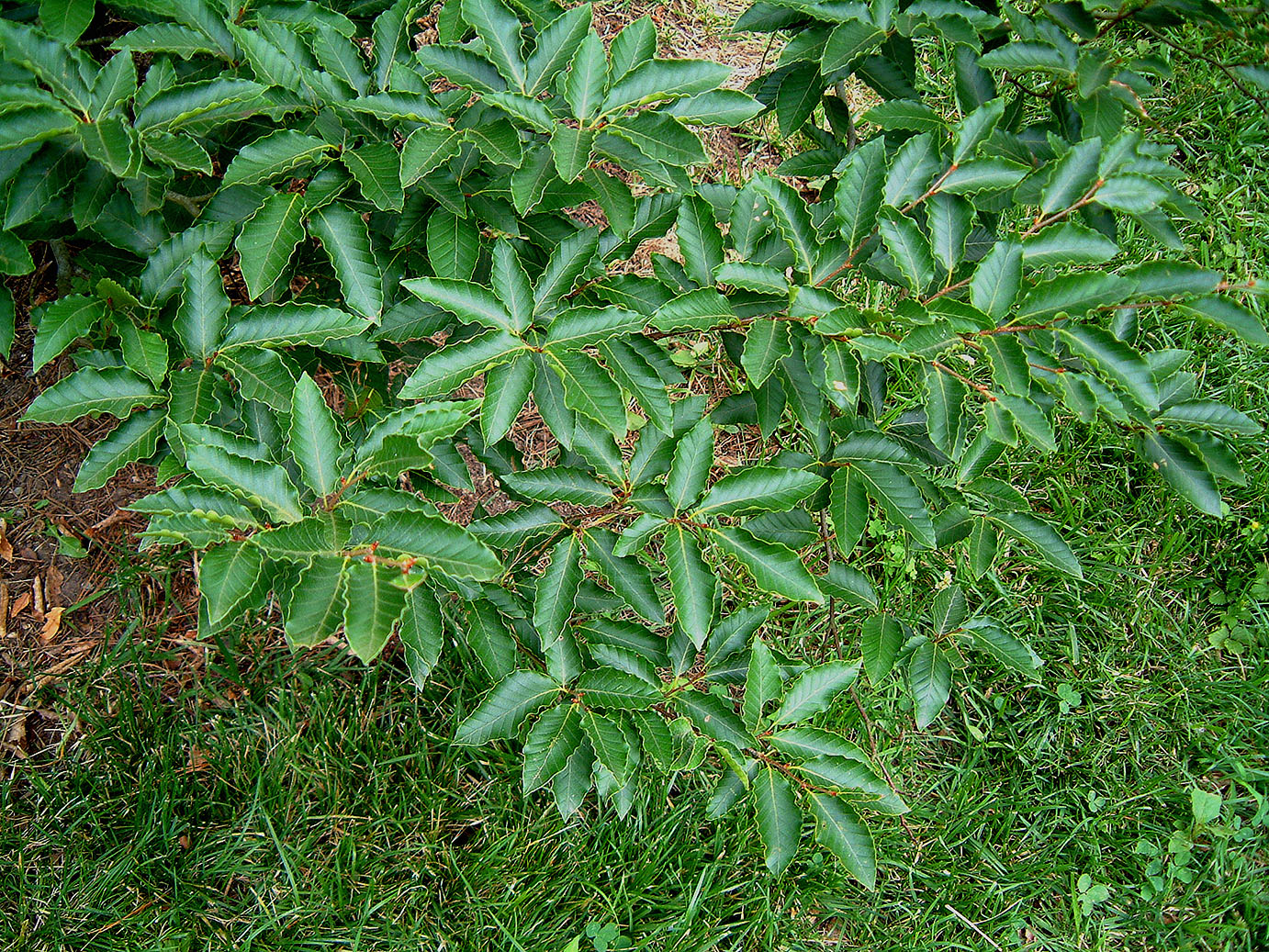 Fagus
crenata - click image
Fagus
crenata - click imageAsiatic Arboretum, Sarah Duke Gardens. Summer 2003. The dark, glossy, and wavy leaf of this species is very appealing. Some plants have very
rich gold fall colors and that is something F. sylvatica is never good at.
|
NOS FAGUS PAGE |
|
Copyright
1998-2004. Laurence C. Hatch. All Rights Reserved. Lawful for online access only by current society members. All downloading, printing, saving to media, or offline use is prohibited. Do not link to this page. |
NOMENCLATURE NOTE: Cultivars under f. purpurea, f. laciniata and other infraspecific botanical taxa are arranged in alphabetical order by cultivar name. We have adopted the classification of W.J. Bean who uses botanical forma for groups of wild-occuring variants, which includes the cutleaf, contorted, weeping and purple groups. Cultivars which belong to two or more groups (ie. weeping and purple) are not assigned one of the formae names.
 Fagus
crenata - click image
Fagus
crenata - click image
Asiatic Arboretum, Sarah Duke Gardens. Summer 2003. The dark, glossy, and wavy
leaf of this species is very appealing. Some plants have very
rich gold fall colors and that is something F. sylvatica is never good at.
 Fagus
crenata - click image
Fagus
crenata - click image
US National Arboretum. Spring 2003. There is nothing more of a dream for a beech
lover than to have their own miniature, desktop grove of
trees. This one has nice maturity and a natural look that is breaktaking. LCH.
Fagus crenata
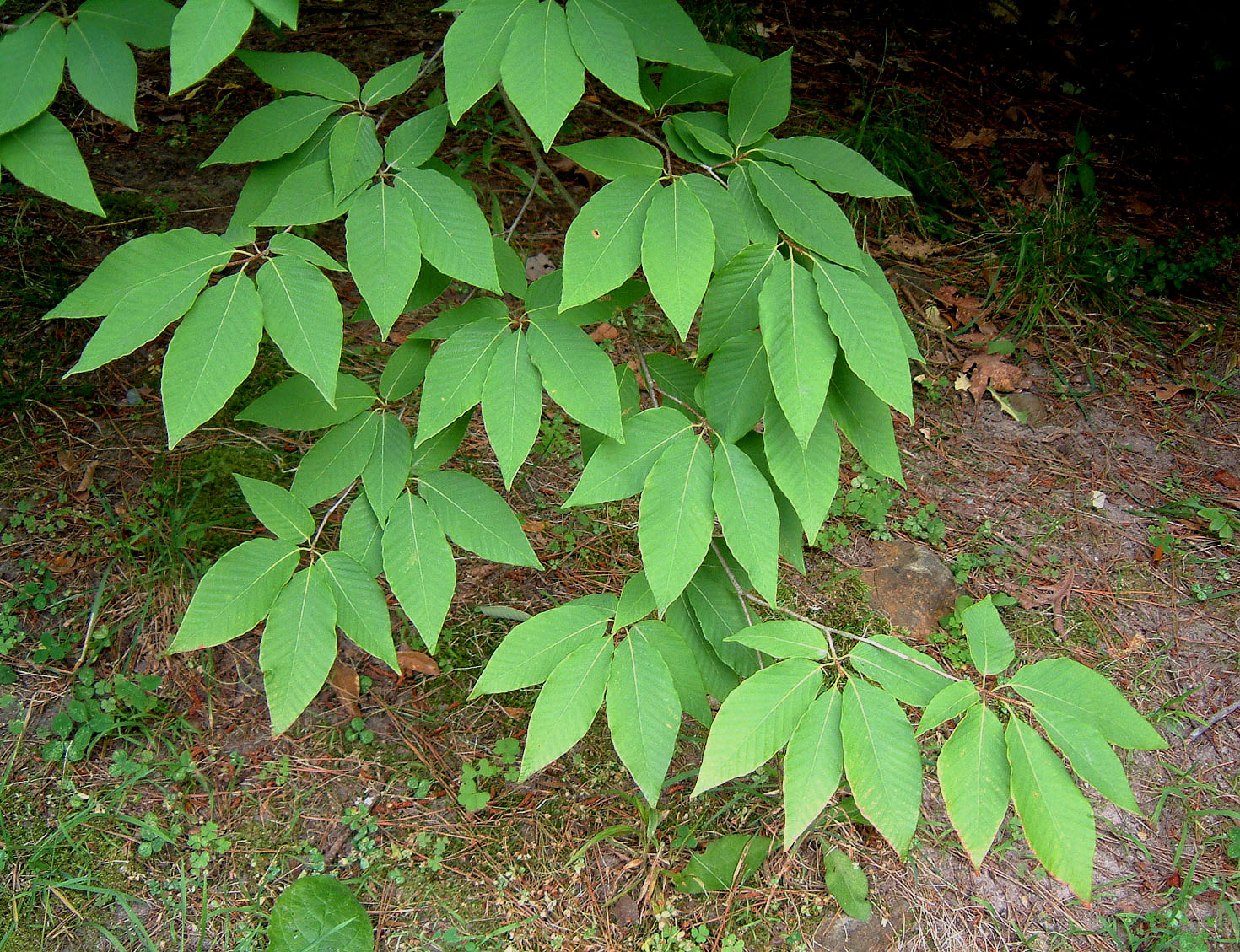 Fagus
engleriana - click image
Fagus
engleriana - click image
Asiatic Arboretum, Sarah Duke Gardens. Summer 2003. This species is everything
that F. crenata is not. It is pale, long-leaved and flat-bladed. The leaves can
easily be 4.5 inches long. The pale color comes partly from a faint glaucous
coating that imparts a very subtle blueness. It is a rare tree even among the
world's arboreta. It is often a multi-trunked plant so the look is certainly
different enough for inclusion where there is enough space for one or two.
Fagus engleriana
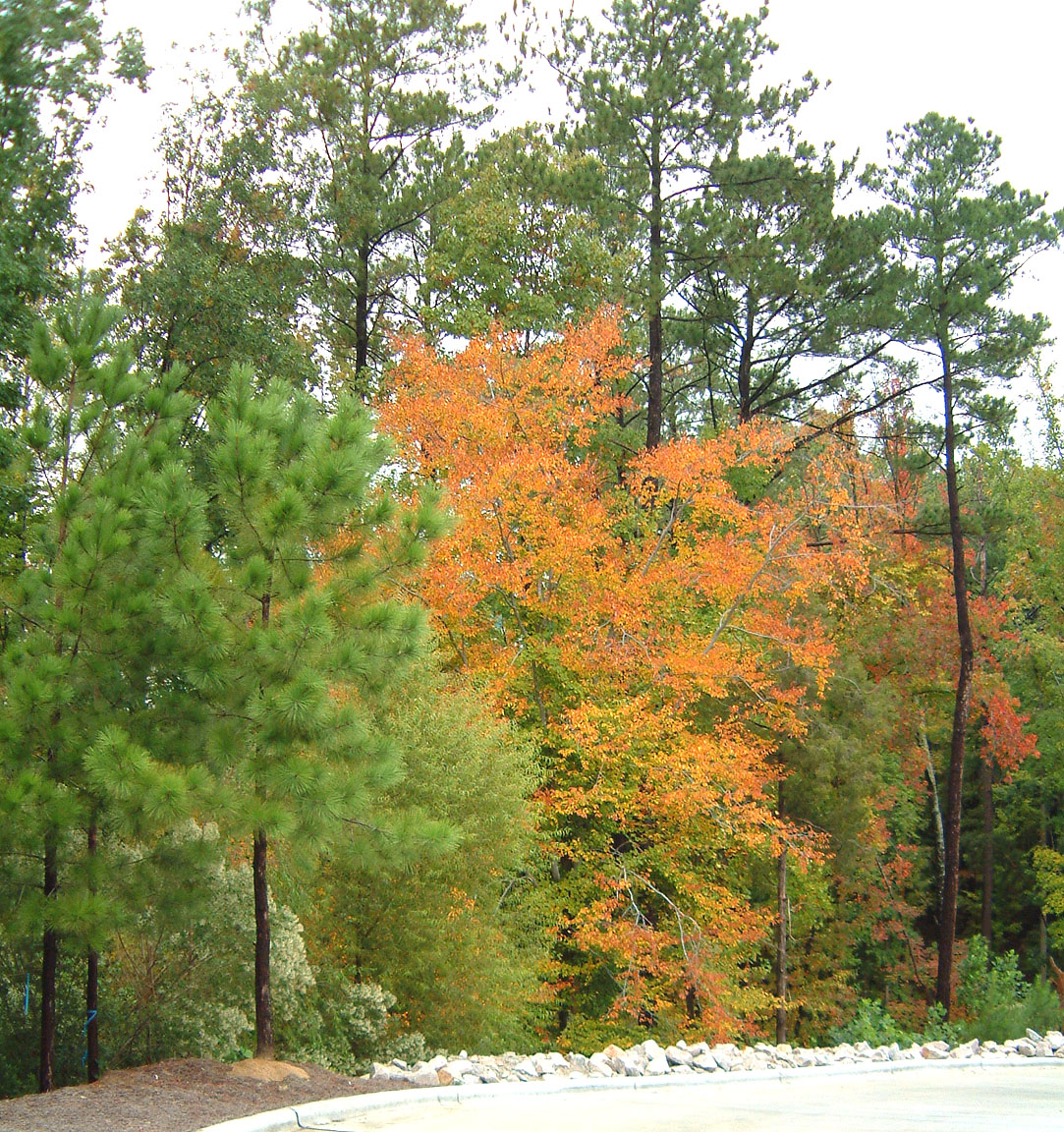 Fagus
grandifolia - click image
Fagus
grandifolia - click image
I wanted to put in a good word for our sometimes overlooked American species.
With all the fancy columnar, weeping, and colored leaves
available in the genus, Fagus grandifolia and it's var. caroliniana here, due
have considerable merits. The example above in North Carolina
(like so many others around the US) exhibits rich orange, gold, and even some
red fall colors. There is room perhaps for selection of some
named clones after careful trials. The plants in this photo include a colorful
Liquidambar styraciflua (far right), various Pinus taeda, and
a patch of blooming Baccharis halimifolia (lower left). LCH.
Fagus grandifolia
Fagus grandifolia var.
caroliniana (Loud.) Fern. & Rehd.
lm: teeth more shallow but longer-pointed than northern US var. grandifolia
frt: husks around nuts more prickly than northern variants
geo: southern US states, while var. grandifolia as first known is more northern
Fagus grandifolia var.
caroliniana f. mollis Fern. & Rehd.
lm, frt, geo: as the variety
lv: blades very downy pubescent below
Fagus grandifolia var.
grandifolia f. pubescens Fern. & Rehd.
lv: blades highly downy pubescent below, much more than most populations
ns: this occurs in the southern variety and is called var. caroliniana f. mollis
Fagus grandifolia 'Shimin'
(11/4)
lc: variegated
or: China as garden sport
ns: named for the originator
li: Zhang, D. and M.A. Dirr. 2004. Potential new
ornamental plants from China. SNA Res. Conf. 2004: 601-603.
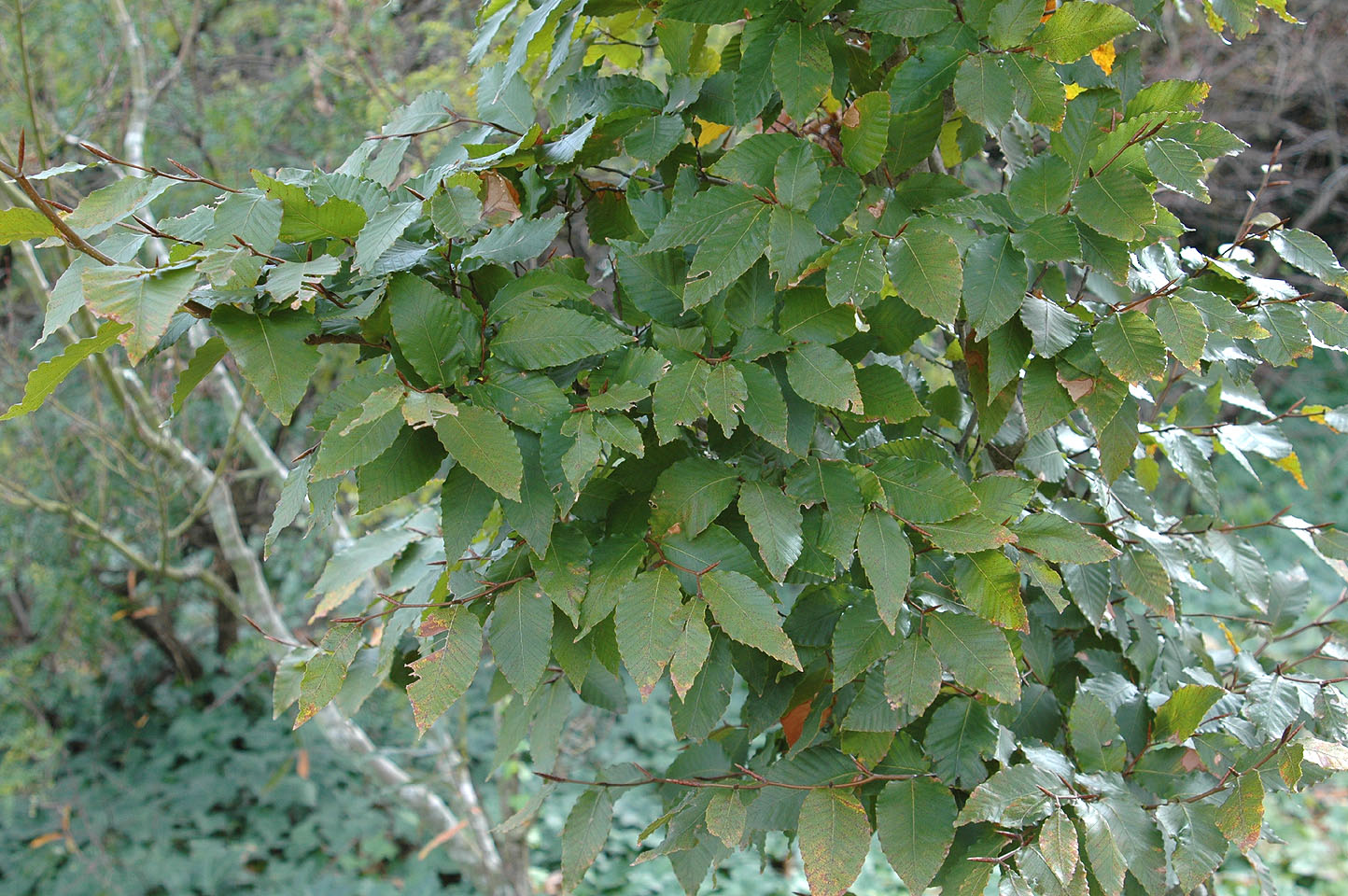 Fagus
mexicana - click image
Fagus
mexicana - click image
JC Raulston
Arboretum. Not so different or impressive really? Of course, if I tell you this
picture was taken on December 11, 2004 you might
think again. This rare species is semi-evergreen and at least "more chlorophyll
persistant". A Fagus grandifolia just feet away was entirely
bronzed out with the familiar clinging dead, papery leaves. This over-the-border
cousin is very rare and you'll not find it in Bean, Jacobson, or
Dirr with this epithet. Fagus grandifolia has traditionally been given as
the name of the entity in northeastern Mexico. But when we have a
semi-evergreen, wider leaved
entity, then a new major taxon is surely justified. The 2004-2005 RHS PLANT
FINDER lists it as subsp. mexicana under the American species as
will some other references. At the risk of appearing politically correct, we
think the specific rank is justified at this time. LCH.
Fagus mexicana
Fagus
sylvatica - Article
web:
Coenosium Gardens (a wonderful
article with photos and good history)
Fagus
sylvatica 'Albovariegata' (f. albo-variegata (West.) Domin.)
lc: irregular creamy white margin, also blotched or sectored in
some variants, fades to greener by summer.
lc: Often reverts. Best effect if pruned regularly to encourage
young shoots.
lm: fewer teeth, more sinuate
ns: this is a polyclonal name for various white-mottled or
margined variants not part of 'Albomarginata'
Fagus
sylvatica 'Albomarginata'
ha: margined white, reversions are common
lw: narrower than species typical
or: Europe c. 1770
li: Gard. Chron. 26: 434 (1899)
Fagus
sylvatica f. purpurea (Aiton) Schneid. 'Ansorgei'
gr: slower than species typical
ls: lanceolate
lm: usually entire
lw: 1-2cm
lc: dark brownish-red
or: Ansorge of Hamburg Germany c. 1891 perhaps as cross of f.
purpurea x 'Comptoniifolia'
Fagus sylvatica f. arcuata = 'Tortuosa' in part
Fagus
sylvatica 'Argenteomarmorata'
lc: mottled white, not a very showy plant. New growth is actually green and only
later marbled and marked. Flushes of
lc: growth in summer add more color.
or: Spath Nurseries, Germany received as seedling 1886, first sold about 1899
Fagus sylvatica f. atropurpurea = f. purpurea
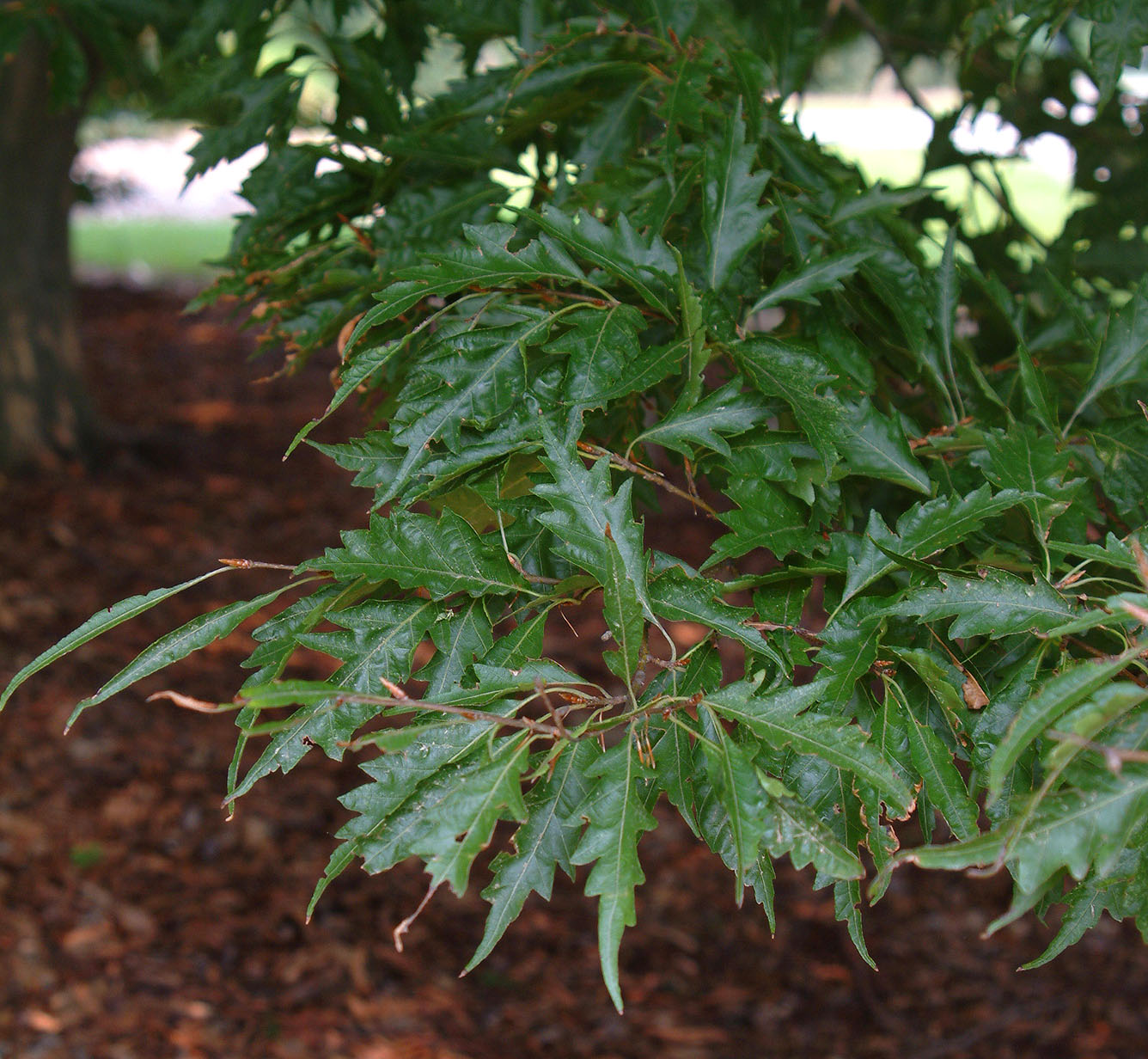 'Asplenifolia'
- click image to enlarg
'Asplenifolia'
- click image to enlarg
Dawes Arboretum. August 2003. If the cutleaf beeches are new to you: study this
photo and the one of 'Laciniata' below.
Fagus
sylvatica f. laciniata (Pers.) Domin 'Asplenifolia'
ht: 60-80 ft. in 100 years or more.
ha: pyramidal, but much more finely textured than the species
ls: deeply incised and lobed, sometimes nearly to the midrib. The
lobes or incisions are irregular unlike 'Laciniata'
ls: which is quite regular and more shallowly cut. Unlike
'Laciniata' this also produces many linear to lanceolate
ls: leaves inside near the trunk (and from some seedlings). It is
extremely variable on some branches but quite
ls: uniform from a distance. One of the tufted, linear-leaved
phases is sold under 'Mercedes'.
eval: It is one of the most beautiful of all cultivars and the
finest of cutleaf trees.
in: Loddiges Nur. Catalog 1804
Fagus
sylvatica f. pendula 'Aurea Pendula'
ha: weeping, typically very narrow and erect as typical 'Pendula'
lc: yellow at first, holding color with a slight bit of shade
or: J.G. van der Bom, Oudenbosch, Holland before 1900
Fagus
sylvatica 'Aurea Variegata' ('Foliis Aureis', 'Paul's Gold
Margined')
lc: margined golden yellow
li: Gard. Chron. 26: 434 (1899)
in: Lawson Nur., Edinburgh
aw: RHS AM 1902 as 'Paul's Gold Margined'
Fagus
sylvatica 'Beth Dwarf'
ha: dwarf, more suitable for smaller gardens
so:
Wells Nursery
Fagus
sylvatica 'Bicolor Sartini' = 'Sartini'
Fagus
sylvatica Striped Group 'Birr Zebra'
lc: green veins with yellowish-green between
the veins. The numerous dark veins give a zebra effect.
in: first sold we believe by Endsleigh Nursery, Devon. UK c. 2001
photo, or:
Birr Castle, Ireland
Fagus
sylvatica f. purpurea (Aiton) Schneid. 'Black Swan'
ht: 5m, slower than 'Pendula'
ha: weeping, upright. Similar to 'Purple Fountain' but wider and
more irregular. It is a somewhat
ha: "ugly duckling" in early years but is more lovely
and interesting with time.
lc: blackish-red
so:
wholesale source (Firma C. Esveld)
Fagus
sylvatica f. pendula 'Bornyensis'
ha: highly pendulous, smaller than typical
'Pendula', foliage very dense
or: found at church at Borny, France before 1900, probably
obtained from a nearby forest
in: Simon-Louis Freres, France c. 1900
Fagus
sylvatica f. purpurea 'Brocklesby'
lc: darker purple, holding color well
ll: larger than most f. purpurea cultivars and seedlings
or: Brocklesby Park, Lincs., England
in: popularized by Spath Nur., Berlin
Fagus
sylvatica 'Cochleata'
ht: 15 ft. (70 years) - that's a dwarf!
ha: very dwarf, conical in time,
ls: elliptic, concave below, base very cuneate, wider above the
middle
lm: numerous small, pointed teeth or small lobes towards the
apex. Krussman states it is also undulate but this he
lm: lumps with 'Undulata'
ll: 3-4 cm - very much smaller
in: Europe c. 1842
li: Loudon. Encyc. Tr. Shrubs p. 1118
Fagus
sylvatica 'Cockleshell'
ha: slightly more upright
ls: small, rounded, shell-like, smaller than 'Rotundifolia'
ns: it is distinct from 'Cochleata' despite somewhat similar
names and descriptions.
or: Hillier Nur. c. 1960 sport of 'Rotundifolia'
Fagus
sylvatica f. laciniata (Pers.) Domin. 'Comptoniifolia'
ha: slower than 'Asplenifolia' in growth rate, hence never as
popular.
ls: similar to 'Asplenifolia' but with more linear leaves and
others more deeply and finely cut.
so: does not seem to be in the modern trade.
lsp: Dortmund Bot. Gard.
li: Kirschner, Arbor. Muscaviense (1864)
Fagus sylvatica f. conglomerata = f. tortuosa
Fagus
sylvatica 'Contorta'
ns: a doubtful name, probably an error for f. tortuosa
so: Toole's Bend Nur. 423-531-7773 (phone or FAX)
Fagus
sylvatica 'Crarae'
ls: asymetrically ovate and recurved
lb: auriculate and oblique-cuneate
lm: deeply lobed to 1/4 to 1/3 depth
li: Spongberg,S.A.1989.HortScience 24(3): 433
rd: 4 Nov. 1988
or: James M. MacKiloy from plant in Crarae Gardens in Scotland
Fagus
sylvatica 'Cristata' ('Crispa')
ha: full-sized but formed off irregular tufts of foliage on the
branches, not a uniform outline. Unless well pruned it has
ha: a frightfully ugly look like a lime-green, poodle-trained
juniper.
ls: oddly crumpled, crested, twisted, irregularly and coarsely
toothed
pet: very short, producing leaves in odd tufts or whorls on the
stems.
eval: purely a novelty but a very curious one. It was offered in
the US in the 70's by Girard Nurseries OH USA
in: Europe before 1836
Fagus
sylvatica f. purpurea 'Cuprea' (Cuprea Group)
lc: copper-purple to bronze-green to
purplish-green, varying with individuals. Correctly called
"copper beech". It is
lc: never dark purple.
ns: this evidently came from seedlings of f. purpurea that are
more bronze or copper in color. They have a different
ns: charm than the purple variants but are nowhere as popular.
This is a collective name for the paler, bronze variants
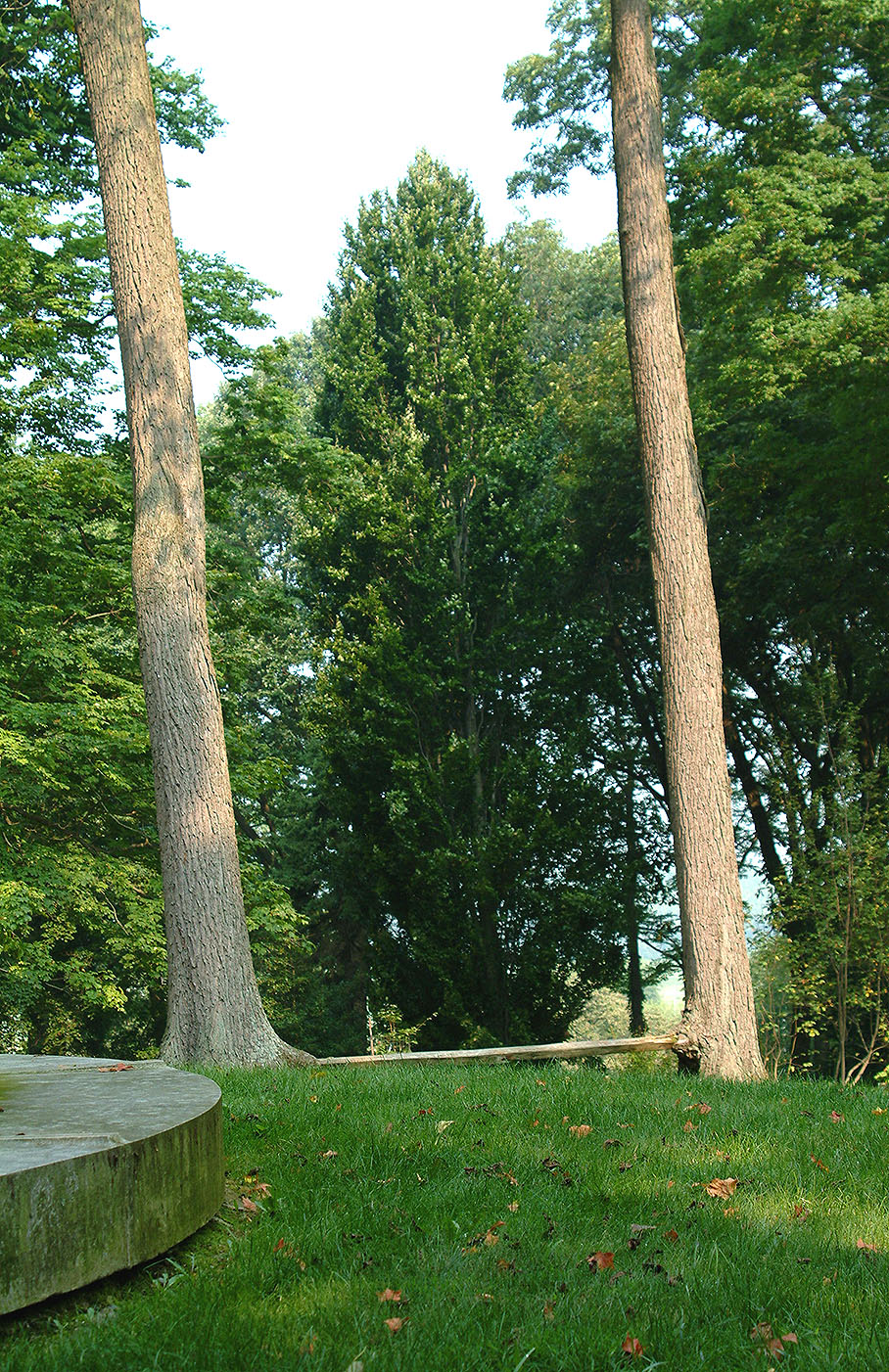 'Dawyck'
- click to enlarge
'Dawyck'
- click to enlarge
Dawes Arboretum. August 2003. This is one of the larger trees in the US. Note
the bases of the curious trees than frame this picture.
Fagus
sylvatica 'Dawyck' ('Dawyckii', 'Fastigiata' misapplied)
ht: 82 ft. (original tree 1966); 75 ft. x 9
ft. wide
ha: fastigiate to columnar
or: Lt.-Col. A. Balfour, Dawyck, Peeblesshire, England from his
garden. It probably came from a nearby wood.
in: to Kew from originator 1907. Hesse Nur, Germany to trade
1912.
ns: see 'Fastigiata' below
Fagus
sylvatica 'Dawyck Gold'
ha: columnar
lc: yellow as in 'Zlatia'
afc: yellow also.
or: Arb. Trompenberg as 'Dawyck' x 'Zlatia' 1968
li: Hoey Smith, J.R.P. van. 1980. The fastigiate copper beech.
The Garden
li: (RHS) 105(7): 292-293.
 'Dawyck Purple'
- click image to enlarge
'Dawyck Purple'
- click image to enlarge
Dawes Arboretum. August 2003. A young but appealing tree that is dark and
charming on a foggy morn.
Fagus
sylvatica 'Dawyck Purple'
ha: columnar
lc: purple as in 'Rohanii'
rai: The 'Rohan Minaret' and 'Red Obelisk' may prove superior for
color
li: Hoey Smith, J.R.P. van. 1980. The fastigiate copper beech.
The Garden
li: (RHS) 105(7): 292-293.
or: Hoey Smith 1968
so:
source (Roslyn
Nursery)
Fagus
sylvatica 'Dentata'
so:
wholesale source (Firma C. Esveld)
(online catalog
2002)
Fagus
sylvatica 'Donerade Purple'
so:
wholesale source (Firma C. Esveld)
(online catalog
2001)
Fagus
sylvatica 'Fastigiata'
ha: columnar to fastigiate
in: Simon-Louis Freres Nur., France before 1873
li: Koch, Dendr. 2(2): 17 (1873)
or: this is a much older clone than 'Dawyck' which is incorrectly
sold under this name.
Fagus
sylvatica 'Feaux de Verzy'
so:
wholesale source (Firma C. Esveld)
(online catalog
2002)
Fagus
sylvatica 'Felderbach' (8/99)
so:
Blue Bell Nursery
Fagus
sylvatica 'Feuerglut' (12/4)
lc: new growth heavily mottled pink at 45-80%, later dark green with pink to red
markings and spots, faintly dotted throughout
or: G. Donig, Erlangen, Germany 1989
li: Houtman, R. 2004. Variegated trees and shrubs: the ill. encyclop. Timber
Press. p. 135, with color photo
Fagus
sylvatica 'Feuermarmor' (12/4)
lc: new growth heavly mottled bright pink to 70%, later dark brownish-brown with
far sparser pink markings at 5-20%.
or: G. Donig, Erlangen, Germany 1991
li: Houtman, R. 2004. Variegated trees and shrubs: the ill. encyclop. Timber
Press. p. 135-136, with color photo
Fagus
sylvatica 'Flagellaris'
so:
wholesale source (Firma C. Esveld)
Fagus
sylvatica 'Foliis Variegatus'
lc: mottled white and yellow, also streaked
with red and purple.
in: Loddiges Nur.
so: does not appear to be in the trade today.
Fagus
sylvatica 'Franken' (8/99)
tw: orangish-brown,
rather showy in winter
lc: mottled pure white at 35-50%, more heavily than 'Marmorata' but less white
than 'Marmor Star'. Older leaves become progressively more green.
or: G. Donig, Erlangen, Germany 1993, seedling of 'Marmorata'
so:
Blue Bell Nursery
Fagus
sylvatica 'Frisco' (8/01)
ls: irregularly cut and lobed, often deeply to the midrib. Teeth
are often rounded but other
ls: leaves are more sharply pointed like 'Laciniata'. There are
often leafllet-like lobes.
so:
wholesale source (Firma C. Esveld)
(online catalog
2001)
Fagus
sylvatica 'Frisio'
lc: dark purple
ns: apparently not the same as 'Frisco'(?)
or: Holland
Fagus
sylvatica 'Fruticosa'
lsp: Arb. Trompenberg 1998
ns: this Latin name, meaning "shrubby", has no
standing.
Fagus
sylvatica 'Grandidentata'
ls: coarsely and regularly toothed, never
deeply cut as f. laciniata, somewhat concave below. Broadly
elliptic
lb: cuneata - narrower
or: Bean suspects it to be a branch sport of 'Asplenifolia'
in: James Booth Nur, Flottbeck, Germany c. 1872. Krussman says
1810 and he is usually right.
Fagus
sylvatica 'Green Obelisk'
lsp: Arb. Trompenberg 1997
Fagus
sylvatica 'Greenwood'
ha: open, not casting dense shade, making it
acceptable to grow lawns under
ll: smaller than species typical, a finer texture
ls: suborbicular (rounded)
so: Coenosium Gardens
so:
Blue Bell Nursery
Fagus
sylvatica 'Haaren'
so:
wholesale source (Firma C. Esveld)
(online catalog
2001)
Fagus
sylvatica 'Haven'
ns: a listed name in the RHS PLANT FINDER
1998. It may be a typo for 'Haaren'.
Fagus
sylvatica 'Heterophylla' = 'Asplenifolia' in part, also f.
laciniata 'Laciniata'
ns: Loudon's use of this name includes the
two variants we keep separate today. It is roughly the same as
our f. laciniata
Fagus
sylvatica 'Horizontalis'
so:
Rich's Foxwillow
Pines Nursery
Fagus
sylvatica 'Horstmann'
so:
wholesale source (Firma C. Esveld)
(online catalog
2002)
Fagus
sylvatica 'Interrupta'
lc: green as typical
ls: interrupted or deeply divided leaves so as to appear nearly
compound
or: Hoey Smith 1955 as 'Rohanii' seedling
ns: This Latinized name has been rightfully questioned but it was
published
ns: in 1955 and thus is within the 1959 limit. The same is
probably not true for 'Interrupta Purpurea'
li: Hoey Smith, J.R.P. van. 1955. Deutsche Baumschule 7: 265,
fig. 154.
li: Hoey Smith, J.R.P. van. 1980. The fastigiate copper beech.
The Garden
li: (RHS) 105(7): 292-293.
li: Int. Dendrol. Soc. Year. 1989: 112
Fagus
sylvatica f. purpurea (Aiton) Schneid. 'Interrupta Purpurea'
lc: purple
ls: interrupted or deeply divided leaves, often split into 2-3
sections
or: Arboretum Trompenberg as 'Rohanii' seedlings.
ns: it is currently unclear if this name was published earlier
(before 1959) that would allow a Latin name to be
ns: used.
li: Meyer, F.G. 1963. Plant Explor. ARS 32-34, 111.
li: Int. Dendrol. Soc. Year. 1989: 112
Fagus
sylvatica 'Jaegerspries'
so:
wholesale source (Firma C. Esveld)
(online catalog
2002)
Fagus
sylvatica 'Kleins Copper' (11/4)
lc: rich copper bronze, a particularly good shade for cloning
or: Yew Dell Arboretum, Crestwood, KY USA before 2003
ns: named for Theodore Klein, founder of the Yew Dell gardens
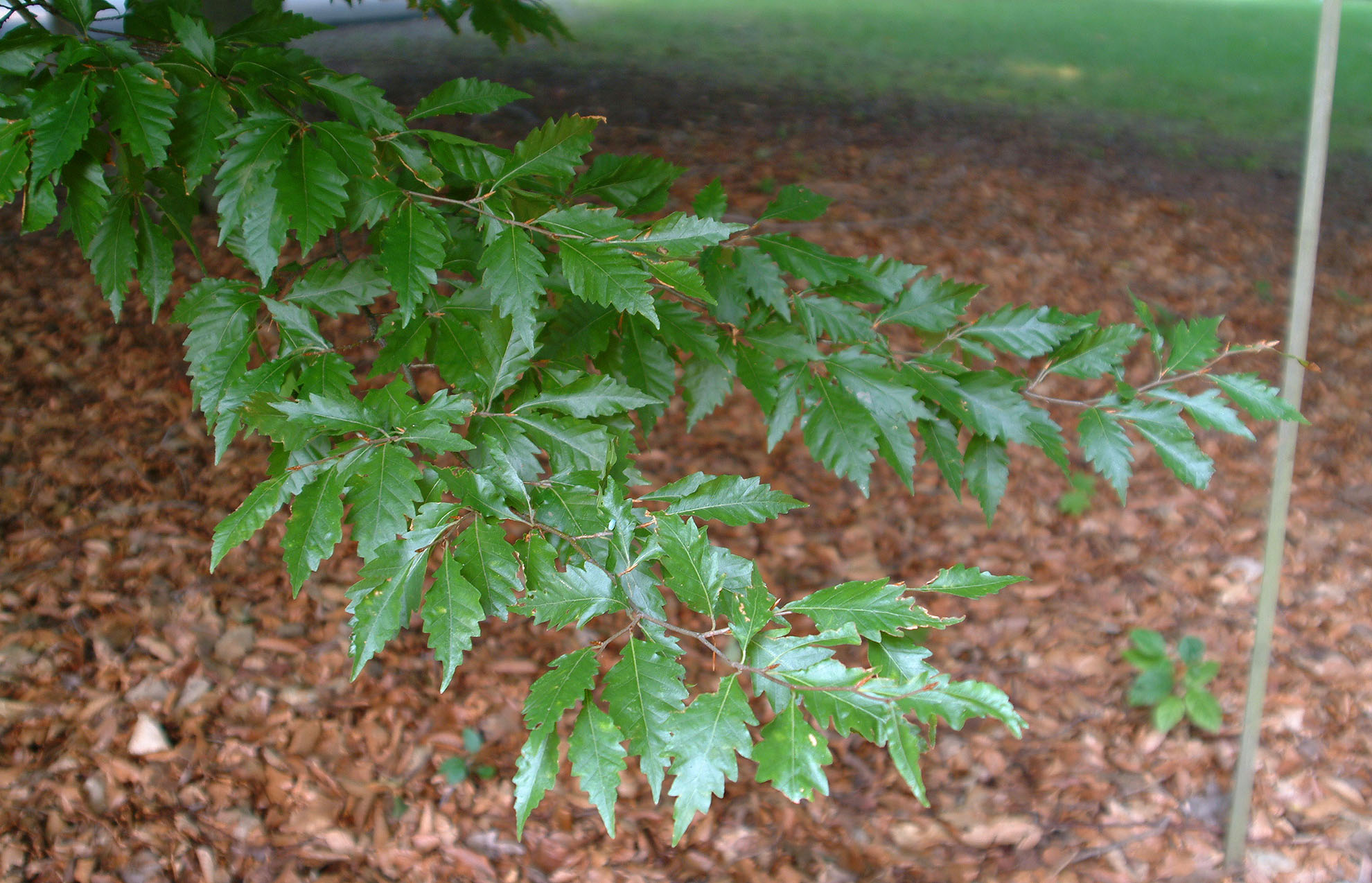 'Laciniata'
- click image to enlarge
'Laciniata'
- click image to enlarge
Dawes Arboretum. August 2003. Note the lack of linear or lanceolate leaves are
the shoot types as found in 'Asplenifolia'
Fagus
sylvatica f. laciniata (Pers.) Domin 'Laciniata'
ls: regularly incised or lobed, less deeply cut than
'Asplenifolia' (less than 1/3 to 1/2 deep), rarely with
linear-leaved shoots
ns: the botanical form groups all the cut-leaves beeches. The
cultivar name is for the popular clone of the same origin as
ns: stated below.
or: Tetschen estate near Bohemia and Saxony c. 1792 from a plant
in the hedgerow. Krussman says 1895.
Fagus
sylvatica f. latifolia Kirsch. (var. macrophyulla Dipp.)
ll: to 15cm - much larger or at least wider
than species typical, not a notable variation for gardens
lw: 9-12cm
lt: thicker, tougher blades
or: Germany c. 1864 possibly from F. moesiaca as it seems to be
an intermeidate.
Fagus
sylvatica f. latifolia 'Latifolia Purpurea'
ns: probably the same as f. purpurea 'Purpurea Latifolia'?
so:
wholesale source (Firma C. Esveld)
(online catalog
2002)
Fagus
sylvatica 'Löndal Krybebög'
lsp: Arb. Trompenberg before 2001
Fagus
sylvatica 'Long Red'
ns: a listed name, reportedly for a clone with a long red blade.
so:
Plantago.nl
Fagus
sylvatica 'Luteovariegata'
ha; more vigorous than 'Albovariegata'
lc: margined, mottled, or sectored yellow. Mostly margined, it
also has some sectors into the main green center.
ns: 'Aurea Variegata' is a specific clone of this type. This name
represents a group according to Bean.
or: England c. 1770
Fagus sylvatica 'Macrophylla' or var. macrophylla = f. latifolia
Fagus
sylvatica 'Marmor Star' (12/4)
lc: mottled pure white at 50-75% of surface, much more 'Marmorata'. Lacks
pinkish tints of 'Franken'. Looks greyish from a distance
la: apiculate
or: G. Donig, Germany 1992 as seedling of 'Mamorata'
eval: this is a true breakthrough in variegated cultivars, given a high chimera
and a breathtaking pattern
li: Houtman, R. 2004. Variegated trees and shrubs: the ill. encyclop. Timber
Press. p. 135-136, with color photo
Fagus
sylvatica 'Marmorata'
lc: darked with faint cream to white spots in new growth, never bold.
id: it is considered more faintly and finer mottled than 'Albomarmorata'
eval: seedlings of it including 'Marmor Star' and 'Franken' have more chimera
and are much showier.
or: Germany 1903
Fagus
sylvatica 'Mercedes'
ht: 1.5m tall x 1.0m wide
ha: dense, dwarf, very fine-textured, shrubby for many years.
lc: bright light green
ls: narrowly linear with lightly cut margins. New growth often
thread-like. This leaf shape
ls: appears in 'Asplenifolia' as watersprouts or in it's
seedlings.
photo, wholesale source:
wholesale source
(Firma C. Esveld)
Fagus
sylvatica f. pendula 'Miltoniensis'
ha: weeping, having a leader and other branches distinctly bent
downward, trailing limbs to the ground
bk: most plants under this name has less smooth bark, having
irregular broken patches.
ns: not all plants under this name are the true, original clone.
or: Milton Park, Northhamptonshire, England before 1837. In the
trade around 1899.
Fagus
sylvatica 'Marmostar' ('Marmor Star')
lsp: Arb. Trompenberg since 1999
so:
wholesale source (Firma C. Esveld)
(online catalog
2001)
Fagus
sylvatica 'Montefiore'
lsp: Arb. Trompenberg 2000
so:
wholesale source (Firma C. Esveld)
(online catalog
2001)
Fagus
sylvatica Striped Group 'Oudenbosch' (12/4)
lc: intervenal areas yellowish much like 'Birr Zebra' and likely a parallel
mutation
or: found as seedling in Oudenbosch, Netherlands
in: Arboretum Oudenbosch, Netherlands 1995
li: Houtman, R. 2004. Variegated trees and shrubs: the ill. encyclop. Timber
Press. p. 136, with color photo
Fagus
sylvatica f. pendula 'Pagnyensis'
ha: weeping, more umbrella-shaped than
ordinary 'Pendula' of gardens, requiring high understock to give
it height.
or: found near Pagny, France
in: Simon-Louis Freres, France
Fagus
sylvatica 'Parkanaur'
ha: 'parasol-shaped' with older limbs contorted
ht: 3m in about 160 years
wd: 7.3m in about 160 years
ll: 'smaller'
or: original tree occurs in Parkanaur Dungannon in Co. Tyrone N.
Ireland
rd: 3 March 1986 by H.S. Crosbie Cochrane of N. Ireland
li: Elwes, H.J. and A. Henry. 1906. Trees of Great Britian and
Ireland.
li: 16-17. (without name).
li: Spongberg, S.A. 1988. Cultivar registration at the Arnold
Arboretum
li: HortScience 23(3): 456.
Fagus
sylvatica 'Parvophylla'
ns: a listed name, presumably have smaller leaves(?).
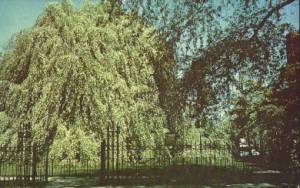 'Pendula'
- an old photograph of the huge plant formerly in Flushing, Queens NY
'Pendula'
- an old photograph of the huge plant formerly in Flushing, Queens NY
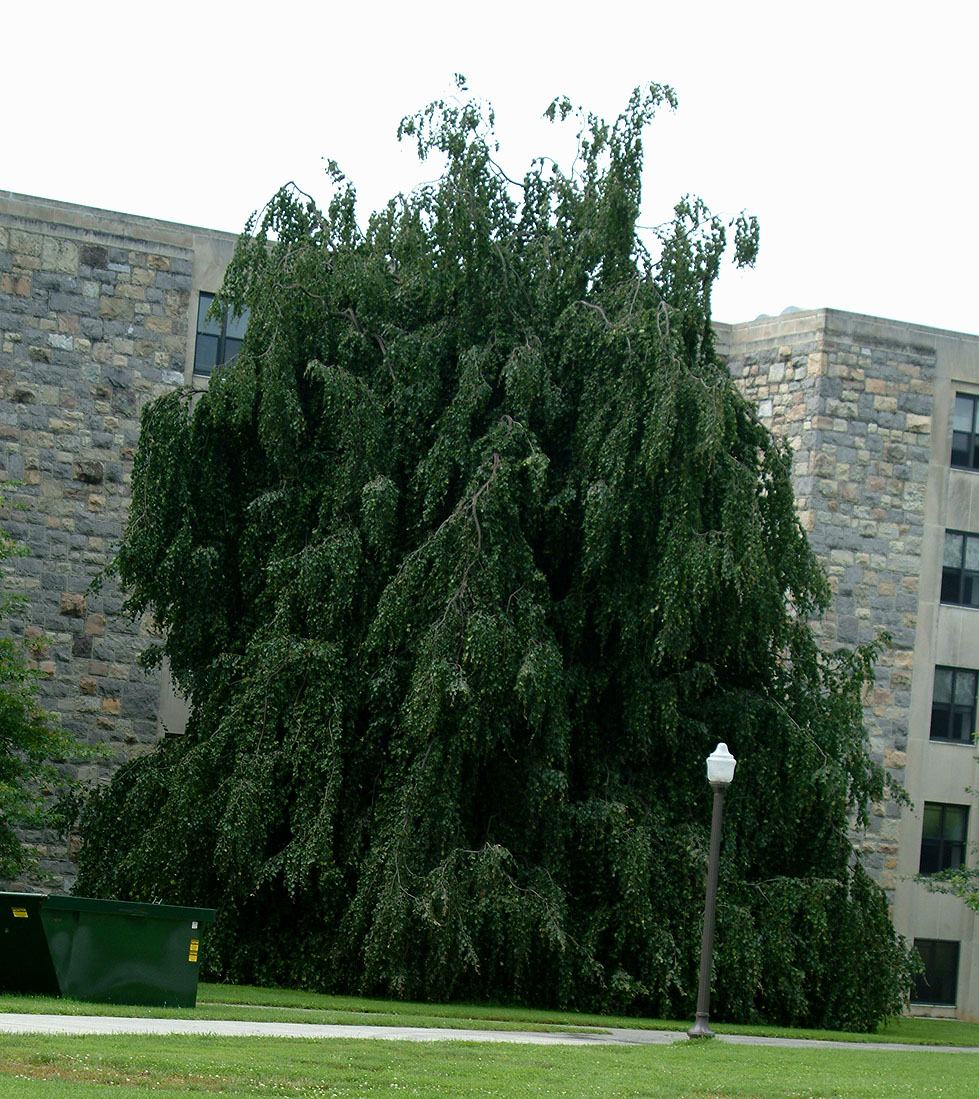 'Pendula'
- click to enlarge
'Pendula'
- click to enlarge
You're cruising through the dense, dark, winding mountains of Virginia. You do
not expect to come upon dormatories made of stone with not one
but three large weeping beech outside them. Such is a fascinating campus at
Virginia Tech University in Blacksburg. Besides the famous football
team their horticultural team is remarkable and inspiring.
Fagus
sylvatica f. pendula (Loud.) Schelle 'Pendula'
ha: weeping, varying from tall and erect to spreading and
mushroom-shaped in the form. The typical 'Pendula' clone of
ha: gardens is somewhat horizontal, wider than tall, forming a
tent of branches 50-100 ft. wide in many years.
or: Loddiges Nursery 1800's for 'Pendula' of gardens today
ns: the botanical form is a useful name since many weeping forms
appear in the wild, about a dozen having been
ns: propagated or named to date. 'Pendula' is used for the
wide-spreading, tent-like clone from Loddiges.
Fagus
sylvatica 'Plaswijck'
lsp: Arb. Trompenberg before 2001.
Fagus
sylvatica 'Prince George of Crete'
ll: larger than typical and often 5-7 in. long and 5 in. wide
so: Coenosium Gardens 503-266-5471
Fagus
sylvatica 'Purple Fountain'
ha: weeping, more erect than 'Purpurea Pendula', fountain-like as
the name implies.
in: Grootendorst 1975 as seedling of 'Purpurea Pendula'
lc: slightly less dark than 'Purpurea Pendula'
so: Fall 1998 catalog -
source (Wayside Gardens)
so:
source (Roslyn
Nursery)
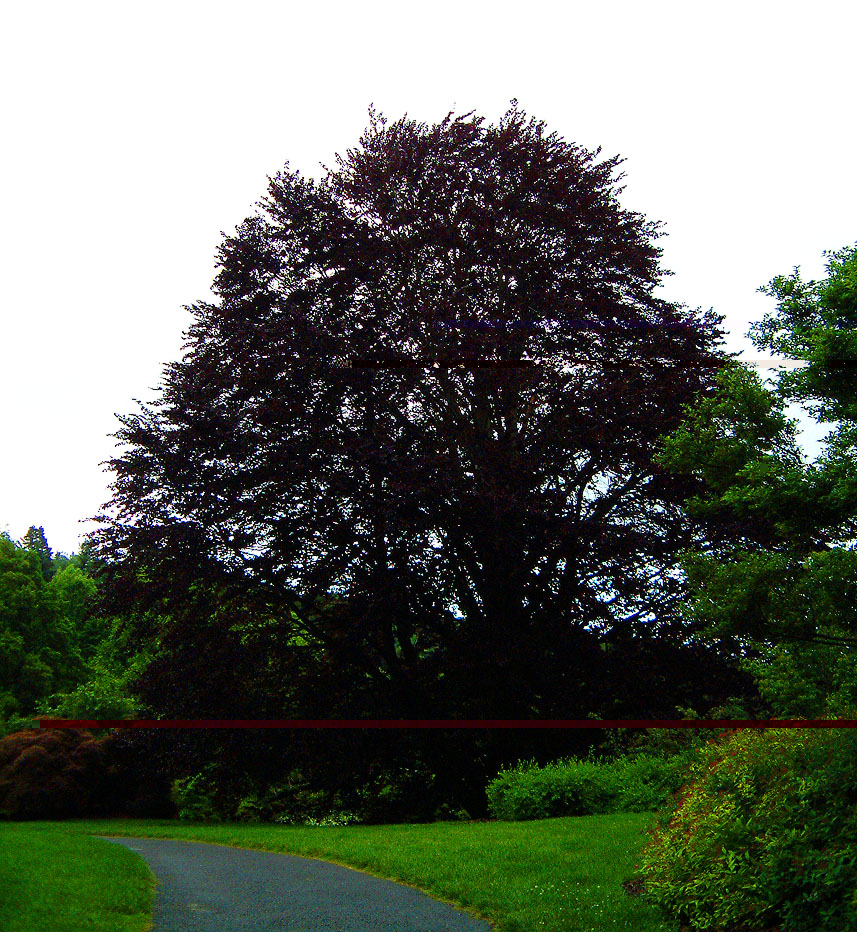 Fagus
sylvatica f. purpurea (Aiton) Schneid - click image
Fagus
sylvatica f. purpurea (Aiton) Schneid - click image
Biltmore Estate Gardens, Asheville, NC. It is rare to find a century old purple
beech in the southeastern US. There are countless hundreds
of old ones in northern US states with Boston, Rochester, and Philadelphia being
especially loaded.
Fagus
sylvatica f. purpurea (Aiton) Schneid ('Atropurpurea',
'Atropunicea', Atropurpurea Group)
lc: bronze-green to very dark blackish-purple, varying with the
seedlings, new growth often more red than purple. Most
lc: the variant turn greener by some and those of the 'Cuprea'
sort are a pale bronze or copper shade with much green.
id: 'Cuprea' is a name used collectively for the more bronze or
copper seedlings.
or: as Bean points out this is not an entity of garden origin, so
use of the botanical form is justified. It has appeared
or: many places and at many times in history. Reports date to as
early as 1680. Bean says most stock in Europe is
or: said to come from a tree in Hanleiter Forest in Thuringia. It
came to Britain about 1760
ns: the RHS use of the name Atropurpurea Group seems unwarranted
since this is clearly not a cultigenic taxon. The
ns: old name of 'Atropunicea' is sometimes seen. It is not valid
since it is based on Weston's name of 1710 and it was
ns: allied to F. grandifolia in error.
Fagus
sylvatica f. purpurea 'Purpurea Latifolia'
lc: purple
lw: wider blade than typical f. purpurea.
Fagus
sylvatica f. purpurea 'Purpurea Nana'
ht: 10 ft. tall x 6 ft. wide (40 years, Arb. Trompenberg)
ha: dwarf, compact
lc: purple
Fagus
sylvatica f. purpurea 'Purpurea Pendula' ('Purpurea Pendula
Nana')
ht: 10-15 ft. tall in many years
ha: weeping to form mushroom-like dome in many years, never erect
as 'Purple Fountain'
lc: purple as in 'Riversii' or other good clones
gr: rather slow compared to 'Purple Fountain'
rai: 'Purple Fountain' is faster and perhaps more erect
ns: Bean says that 'Purpurea Pendula Nana' could prove to be the
older name.
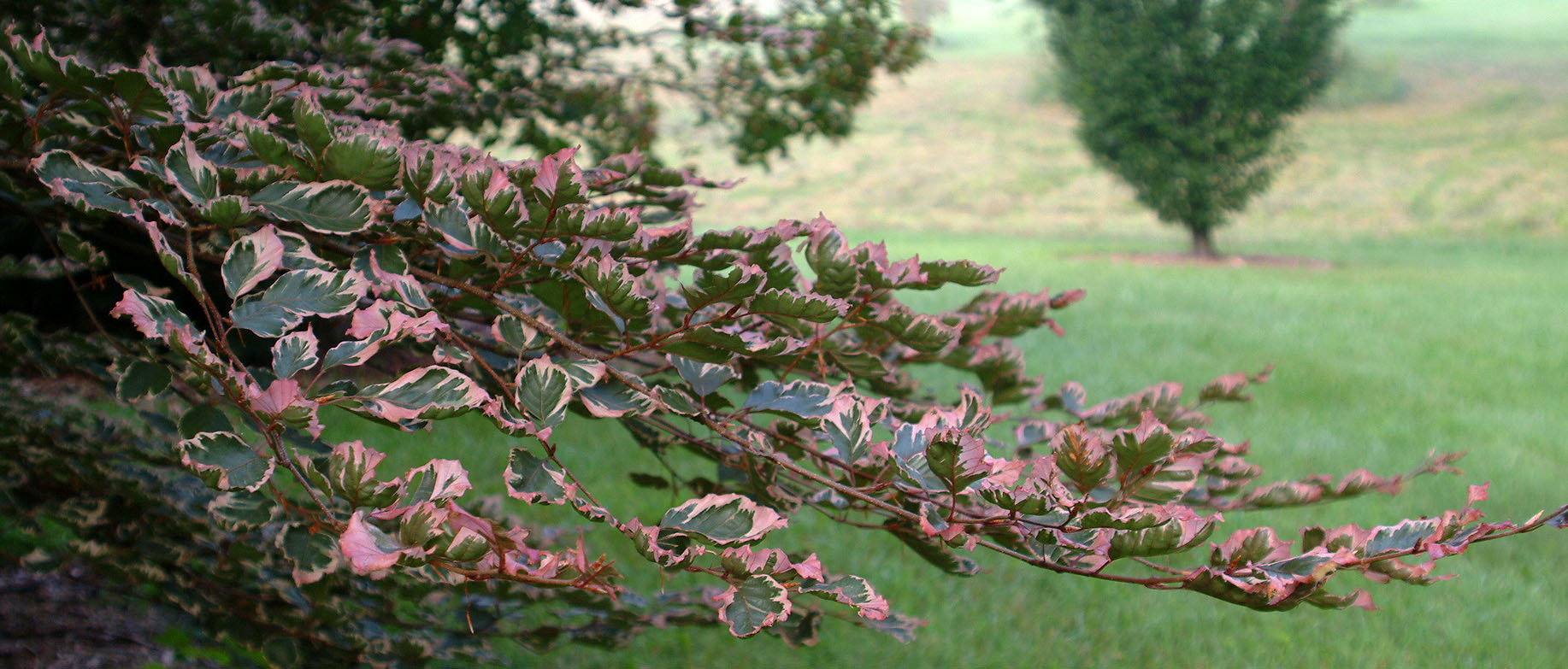 'Purpurea
Tricolor' - click to enlarge
'Purpurea
Tricolor' - click to enlarge
Dawes Arboretum. August 2003. Whether backlit or frontlit, this cultivar has a
rosey border than just looks smashing on a sunny day.
Fagus
sylvatica f. purpurea 'Purpurea Tricolor' ('Tricolor' misapplied)
lc: medium purple margined pink becoming margined pinkish-white.
It has a lovely set of colors when viewed from below
lc: with sunlight allowed to pass through the canopy. Must be
viewed up close for best effect.
lw: slightly narrower than species typical
in: Transon's Nursery, Orleans c. 1885, perhaps sold elsewhere.
Fagus
sylvatica 'Red Obelisk'
ha: columnar as in 'Fastigiata'
lc: red to reddish purple
ls: slightly cut as in 'Rohanii'
so:
source (Roslyn
Nursery)
Fagus
sylvatica f. pendula 'Retroflexa'
ha: weeping, more umbrella-shaped than
ordinary 'Pendula', similar to 'Pagnyensis'
in: Simon-Louis Freres, France
Fagus
sylvatica f. purpurea 'Riversii'
lc: rich purple, holding color longer into summer than the basic
form.
eval: for many decades this was "the" purple beech
cultivar to grow for best color. Today some others like 'Swat
Magret'
eval: are preferred.
or: Rivers Nursery, Sawbridgeworth, England 1870's
Fagus
sylvatica 'Rolf Marquardt' ('Rolph Marquardt')
lc: light green to yellowish-green, heavily striped and mottled white, cream,
and yellow. It has yellow that 'Mamorata' lacks
or: G. Donig, Germany 1992 as 'Marmorata' seedling.
so:
wholesale source (Firma C. Esveld)
(online catalog 2002, as 'Rolph Maequart'
li: Houtman, R. 2004. Variegated trees and shrubs: the ill. encyclop. Timber
Press. p. 137, with color photo
Fagus sylvatica f. quercifolia = f. laciniata
Fagus
sylvatica 'Quercina'
ha: 40 ft. (40 years) - smaller
ls: oak-like, shallowly lobed much like a green version of
'Rohanii'
or: Czechoslovakia 1888
Fagus
sylvatica f. quercoides (Pers.) Domin.
bk: oak-like, having distinct patterns or plates of bark
geo: occurs in the wild
or: first noticed by Persoon in the woods in Gottingen, Germany.
Originally considered be a hybrid to oak trees!
ns: must not be confused with f. quercifolia which has oak-like
leaves and is the same as f. laciniata
Fagus
sylvatica 'Red Obelisk' ('Rohan Obelisk')
ha: columnar as 'Dawyck'
lc: purplish-red
ls: most leaves undulating, shallowly lobed as 'Rohanii', others
not cut or lobed at all/.
or: Arb. Trompenberg
Fagus
sylvatica f. pendula 'Remillyensis'
ht: 36 ft. (Kew Gardens c. 90 years old)
ha: weeping, somewhat contorted, dome or mushroom-shaped with
age, never erect as typical 'Pendula'
in: Simon-Louis Freres, France before 1873
 'Rohanii'
- click to enlarge
'Rohanii'
- click to enlarge
Chadwick Arboretum, Ohio State University. August 2003. This undulate and
lightly lobed beech is darker and more purple in spring.
Fagus
sylvatica f. purpurea 'Rohanii'
lc: brownish-purple
ls: irregularly incised or serrated as f. laciniata but more
shallow and with rounded teeth unlike most of its variants.
ls:Tthe blades usually have a nice undulation or wave to them.
or: Prince Camille de Rohan estate, Sychrov, Czechoslovakia from
seedlings sown 1888. It is probably an accidental
or: cross of 'Brocklesby' and f. laciniata found on the grounds.
in: V. Masek c. 1908 to trade
eval: 'Rohan Trompenberg' holds the color better and should
replace it.
Fagus
sylvatica 'Rohan Gold'
lc: bright yellow as 'Zlatia' becoming typical green
lm: cut to serrate or lobed
or: Arb. Trompenberg
Fagus
sylvatica 'Rohan Grandid'
lsp: Arb. Trompenberg 1978, apparently for a hybrid of
'Grandidentata'
Fagus
sylvatica 'Rohan Green'
ls: undulate, lobed as 'Rohanii'
lc: green
Fagus
sylvatica 'Rohan Lace'
lsp: Arb. Trompenberg 1978
Fagus
sylvatica 'Rohan Laciniata'
lsp: Arb. Trompenberg before 2001.
Fagus
sylvatica 'Löndal Krybebög'
lsp: Arb. Trompenberg before 2001
ns: a listed name, likely invalid in Latin form.
Fagus
sylvatica 'Rohan Minaret' ('Rohanii' x 'Dawyckii')
ha: columnar and perhaps narrower than 'Red Obelisk'
ls: cut as 'Rohanii' but more consistant than 'Red Obelisk'
lc: purple
hp: reverse cross of 'Red Obelisk' but identical parent cultivars
li: Int. Dendrol. Soc. Year. 1989: 112
Fagus
sylvatica 'Rohan Obelisk' = 'Red Obelisk'
Fagus
sylvatica 'Rohan Pyramid' ('Rohan Pyramidalis')
ns: a listed name for a 'Rohanii' hybrid with pyramidal form.
Fagus
sylvatica 'Rohan Trompenburg'
lc: darker purple red than 'Rohanii' , not fading as much by
summer.
lm: nicely cut
ls: longer pointed than 'Rohanii'
rai: better color and leaf shape than 'Rohanii'
li: Int. Dendrol. Soc. Year. 1989: 112
so: Coenosium Gardens 503-266-5471
Fagus
sylvatica 'Rohan Weeping'
lsp: Arb. Trompenberg 1997
Fagus
sylvatica 'Rohan XXX'
ns: a listed name, presumably a provisional entity.
Fagus
sylvatica 'Roseomarginata'
lc: margined rose-pink becoming margined paler pinkish-white,
base color purple.
id: it is sometimes considered a synonym of 'Purpurea Tricolor'
and as a result many plants under this name
id: are of that clone. Historically it is a separate entity.
in: Cripps Nur. c. 1888
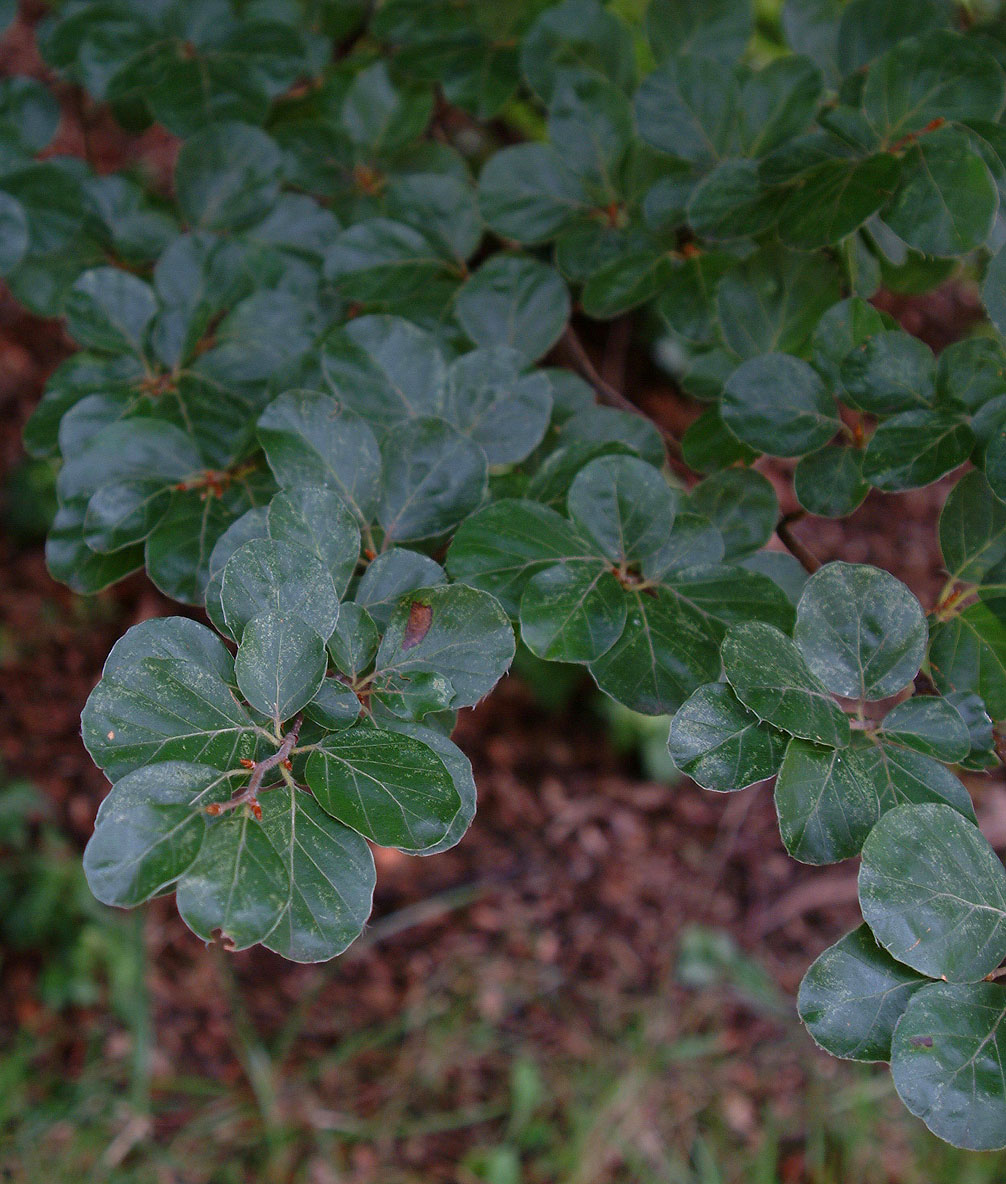 'Rotundifolia'
- click to enlarge
'Rotundifolia'
- click to enlarge
Dawes Arboretum. August 2003. This lightly chewed beauthy is made of thousands
of green coins. It has a finer foliage look.
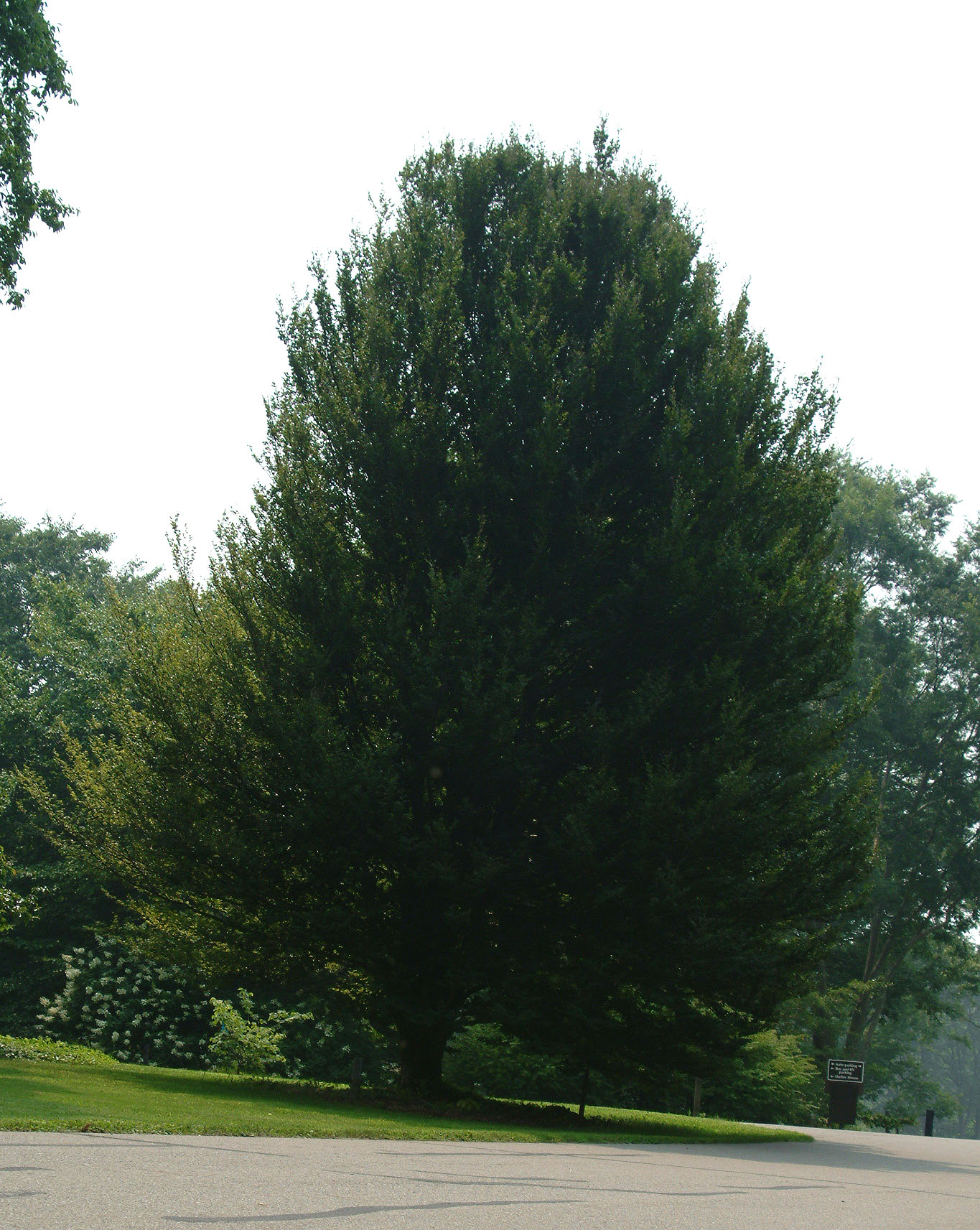 'Rotundifolia'
- click to enlarge
'Rotundifolia'
- click to enlarge
Dawes Arboretum. August 2003. This
second shot illustrates the more
upright, ovoid habit
Fagus
sylvatica 'Rotundifolia'
ht: more ascending than species typical, typical broadly oval to more narrowly
pyramidal.
ls: orbicular to suborbicular, having the look of green coins,
giving a finer texture. Usually 4 veins pairs - much fewer.
ll: 0.5-1.25 in. long - much smaller
or: found near St. Johns, Woking, England before 1872
in: Jackman Nur. to trade 1894
Fagus
sylvatica 'Sartini' ('Bicolor Sartini' as Latin is invalid)
lc:margined yellowish-green to green.It has no purple pigments as the parent.
lt: blades often rugose, giving much texture
lw: slightly narrower than 'Luteovariegata'
or: Sartini Nursery, Piatto, Italy introduced 1995, sport of 'Purpurea Tricolor'
Fagus
sylvatica 'Schlegel'
lsp: Arb. Trompenberg before 2001
Fagus
sylvatica 'Silberthaler' (12/4)
lc: broadly and irregularly margined white, more so than most marginate
cultivars, easily 25-35% of surface, often with
lc: large white sectors intruding to the midrib, the dark green central zone
often divided into distinct zones or lobes. It reverts easily.
or: G. Eschrich, Recklinghausen, Germany 1993
li: Houtman, R. 2004. Variegated trees and shrubs: the ill. encyclop. Timber
Press. p. 137, with color photo
Fagus
sylvatica 'Silverwood'
lc: thinny and irregularly margined cream becoming white, chimera mostly 2-5mm
deep with some deeper sectors but these rarely
lc: touching the midrib. Surface of the chimera is barely 10-20% compared to
wider margined clones such as 'Silberthaler' and 'Albomarginata'.
or: B. Bomer, Zundert, Netherlands, introduced 1986
so: wholesale source (Firma C. Esveld)
li: Houtman, R. 2004. Variegated trees and shrubs: the ill. encyclop. Timber
Press. p. 137, with color photo
Fagus
sylvatica 'Spa'
so:
wholesale source (Firma C. Esveld)
(online catalog
2002)
Fagus
sylvatica f. purpurea 'Spaethiana'
lc: dark purple, retaining color into the summer.
or: Spath Nurseries, Germany
Fagus
sylvatica Striped Group 'Striata'
lc: striped and veined yellowish-green to light green, often in a
radiating pattern, not popular nor very showy.
in, or: Germany c. 1851. Sold by Spath in 1892 but their source is unrecorded.
See Striped Group below.
Fagus
sylvatica Striped Group
lc: areas between secondary veins (off the midrib) whitish, cream, or yellow,
varying with the mutation or clone
id: clones 'Birr Zebra', 'Oudenbosch', and 'Striata' are known. Houtman mentions
that a sport occured in 1850 in
id: Czech Republic of similar striping. It was apparently not named unless it
traces to 'Striata' known n Germany in 1851.
Fagus
sylvatica f. purpurea 'Swat Magret'
lc: very dark purple, sometimes blackish, holding color most of
the summer.
or: Timms & Co, Germany
Fagus
sylvatica 'Tricolor' ('Roseomarginata'?)
lc: pink margins becoming whiter, base color green not purple as
in 'Purpurea Tricolor'. Can burn badly in bright sun.
ns: plants under this name are often 'Purpurea Tricolor'
eval: the colors of 'Purpurea Tricolor' are much more pleasant
in: Simon-Louis Freres, France
Fagus
sylvatica 'Undulata'
ls: undulate, concave, apparently very
similar to 'Cochleata'
in: Simon-Louis Freres Nursery, France 1800's
Fagus
sylvatica f. tortuosa (Pepin) Hegi ('Tortuosa', 'Contorta'?, f.
conglomerata)
ha: contorted, twisted branches, usually wider than tall, but
varying with the selection. It is usually a spreading shrub
ha: at first, later dome-shaped. There are intermediates to
weeping forms ('Remillyensis') but this name is used for those
ha: without very distinctly drooping limbs. Tips may droop but
not the entire limb.
or: found in the wild many times and places in France, Denmark,
Sweden, and Germany. The stock in the US almost
or: certainly derives from the notable trees at the Arnold
Arboretum.
Fagus
sylvatica f. tortuosa 'Suentelensis'
ha: semi-dwarf, highly contorted and twisted, having a very
picturesque dense crown
lc: red
ns: apparently different from f. tortuosa 'Tortuosa Purpurea' but
this is not confirmed.
photo, history:
Suentel website
Fagus
sylvatica f. tortuosa 'Tortuosa Purpurea'
ha: twisted limbs as in 'Tortuosa'
lc: red to purple
ns: Latin name is probably not valid?
Fagus
sylvatica 'Viridivariegata'
lc: mottled lighter green to yellowish-green, not a pretty or regular chimera
though covering up to 50%. It is strictly for
lc: collectors as a full dozen other variegated clones are more showy and
bright.
or: Lombarts Nurseries, Zundert, Netherlands 1935
Fagus
sylvatica 'Zlatia'
ha: slower than species typical, a smaller tree.
lc: yellow at first, becoming yellow-green than finally green. It
is not a golden shade ever.
or: found near Vranje, Serbia
in: Spath Nurseries, Germany c. 1890
ns: the name is based on the Serbian word "zlato" for
gold.
lu: one acheives a nice effect interplanting this with purple and
green-leaved beech cultivars.